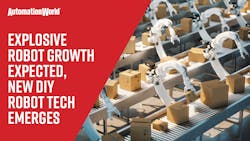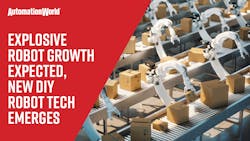Quick hits:
- CPG industry robot use expected to reach 93% by 2027.
- 83% of companies across industry expect to add robots in the next two years.
- Beckhoff’s ATRO modular robot technology allows users to create the robot type needed for specific applications.
Welcome to Automation World’s Technology Matters. I’m David Greenfield, Director of Content, and today we’re going to look at the growing use of robots across industry and the introduction of a new, do it yourself, customizable robot.
To start off by looking at the growing use of robots, a recent study released by PMMI, Automation World’s parent organization, indicates that 84 percent of consumer packaged goods companies now use robots somewhere on their production lines, and this number is expected to rise to 93 percent in the next five years. And deployment of collaborative robots, also known as cobots, is also expected to see strong growth, with use more than doubling from 27 percent this year to 57 percent in 2027. Respondents to the PMMI research say improvements in robot functionality, such as vision, self-learning, and artificial intelligence are spurring manufacturers to purchase and use more robots in processing and packaging applications.
Looking across all manufacturing and processing industry sectors, recent research conducted by Automation World shows similar high growth trends for robots. In Automation World’s research, 83 percent of respondents said they are looking to add robots in the next two years. Helping drive this figure is the fact that 29 percent of respondents currently don’t use any robots at all, and only 12 percent note that more than 50 percent of their production operations involve the use of robots.
Of the robot types used in production operations, 73 percent of respondents said they use industrial robots, 39 percent use cobots, and 30% are using autonomous mobile robots.
When asked to rank the issues affecting their use of robots, 45 percent of respondents to the Automation World study said labor issues were the primary factor, while 30 percent noted increased speed and throughput, and 20 percent cited quality improvements.
Numerous new robotic technologies have debuted over the past two decades, but the new ATRO robot system from Beckhoff may be one of the first build-it-yourself robot technologies for the industrial market. The ATRO is a modular industrial robot system that allows end users, integrators, and machine bfuilders to create an optimal robot configuration for their application.
The system is comprised of standardized motor modules with integrated drive functionality, link modules of various designs and lengths, and the TwinCAT control platform. With these components, users can create robotic systems ranging from 1-axis rotary indexing tables and 3-axis delta robots to 6- and 7-axis articulated robots.
Beckhoff notes that all ATRO modules feature an internal media feed for data, power, and fluids, such as vacuum pressure, air, and water. This allows ATRO to use a variety of end effector tools, such as mechanical, pneumatic, or electric grippers. Because these media feeds are internal, ATRO axes and end effector tools can endlessly rotate because there are no external cables to obstruct the robot’s range of motion. Now, before going further into ATRO’s details, I should point out that this is an early preview of ATRO. The technology is not yet available for purchase but is expected to be available later this year.
The ATRO system can handle payload capacities ranging from 3 to 10 kilograms with a reach from 0.6 to 1.3 meters. Information on ATRO’s speeds has not yet been released, but Beckhoff plans to release that information soon.
Beyond its customizable design configuration, another interesting aspect of ATRO is its assembly, which is accomplished using a method similar to a slip ring to connect each module with an adjustable tool to secure the joint in place.
Through this assembly process, all power, communication, and fluids are connected. And as each module is connected, a light lining the joint connection illuminates. When the light is yellow, it’s verified that EtherCAT communications between the modules is effective; a green light indicates the module is ready for operation; and a blue light indicates the unit is ready for manual teach mode.
Regarding specific applications for which ATRO will be best suited, Beckhoff says ATRO can be added to any application, but common applications will likely be for assembly, material handling, lab automation, and packaging.
So I hope you enjoyed this Technology Matters episode. Keeping watching this space for regular updates on advances in and applications of industrial automation technology.
Leaders relevant to this content:






